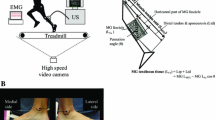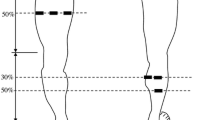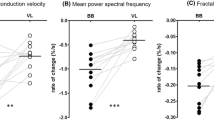Abstract
In earlier studies, we found more economical runners having a more compliant quadriceps femoris (QF) tendon at low force levels, and a higher contractile strength and stiffness at the triceps surae (TS). To better understand how these differences influence force generation economy and energy recovery, we simulated contractions using a Hill-type muscle model and the previously determined muscle properties as input parameters. For eight different activation levels, we simulated isovelocity concentric contractions preceded by an isovelocity stretch. The length changes and contraction velocities imposed to the muscle–tendon units (MTU) corresponded to those happening whilst running. The main results of the simulations were: (a) a more compliant tendon at low force levels (QF) led to an advantage in force-generation due to a decrease in shortening velocity of the CE, (b) a higher contractile strength and higher stiffness at the TS led to a disadvantage in force-generation at high activation levels and to an advantage at low activation levels. In addition at the high economy runners both MTUs showed an advantageous energy release during shortening, which at the QF was mainly due to a higher elongation of the SEE and at the TS mainly to the higher contractile strength. Especially at low activation levels both MTUs showed an advantageous force generation per activation and a higher energy release as compared to the low economy runners.
Similar content being viewed by others
References
Alexander RM, Vernon A (1975) The dimensions of knee and ankle muscles and the forces they exert. Human Movement Stud 1:115–123
Alexander RM, Bennet-Clark HC (1977) Storage of elastic strain energy in muscle and other tissues. Nature 265:114–117
Alexander RM (2002) Tendon elasticity and muscle function. Comp Biochem Physiol A Mol Integr Physiol 133:1001–1011
Arampatzis A, Karamanidis K, De Monte G, Stafilidis S, Morey-Klapsing G, Brüggemann GP (2004) Differences between measured and resultant joint moments during voluntary and artificially elicited isometric knee extension contraction. Clin Biomech 19:277–283
Arampatzis A, Stafilidis S, Demonte G, Karamanidis K, Morey-Klapsing G, Bruggemann GP (2005a) Strain and elongation of the human gastrocnemius tendon and aponeurosis during maximal plantarflexion effort. J Biomech 38(4):833–841
Arampatzis A, Morey-Klapsing G, Karamanidis K, Demonte G, Stafilidis S, Bruggemann GP (2005b) Differences between measured and resultant joint moments during isometric contractions at the ankle joint. J Biomech 38(4):885–892
Arampatzis A, Karamanidis K, Stafilidis S, Morey-Klapsing G, Demonte G, Bruggemann GP (2005c) Effect of different ankle- and knee-joint positions on gastrocnemius medialis fascicle length and EMG activity during isometric plantar flexion. J Biomech DOI:10.1016/j.jbiomech.2005.05.010
Behm DG, Whittle J, Button D, Power K(2001) Intermuscle differences in activation. Muscle Nerve 25(2): 236–243
Bobbert MF (2001) Dependence of human squat jump performance on the series elastic compliance of the triceps surae: a simulation sudy. J Exp Biol 204:533–542
Cavanagh PR, Williams KR (1982) A physiologist’s view of running economy. Med Sci Sports Exerc 14:30–35
D’Antona G, Pellegrino MA, Adami R, Rossi R, Carlizzi CN, Canepari M, Saltin B, Bottinelli R (2003) The effect of ageing and immobilization on structure and function of human skeletal muscle fibres. J Physiol 552:499–511
Daniels JT (1985) The effect of stride length variation on oxygen uptake during distance running. Med Sci Sports Exerc 17(3):332–338
Epstein M, Herzog W (1998) Theoretical Models of Skeletal Muscle. Biological and mathematical considerations, Wiley-VCH, New York
Ettema GJC, van Soest AJ, Huijing PA (1990) The role of series elastic structures in prestretch-induced work enhancement during isotonic and isokinetic contractions. J Exp Biol 154:121–136
Ettema GJC (1996) Mechanical efficiency and efficiency of storage and release of series elastic energy in skeletal muscle during stretch-shorten cycles. J Exp Biol 199:1983–1997
Ettema GJC (2001) Muscle efficiency: the controversial role of elastic and mechanical energy conversion in stretch-shortening cycles. Eur J Appl Physiol 85:457–465
Frontera WR, Suh D, Krivickas LS, Hughes VA, Goldstein R, Roubenoff R (2000) Skeletal muscle fiber quality in older men and women. Am J Physiol Cell Physiol 279:611–618
Fung YC (1993) Biomechanics: mechanical properties of living tissues. 2nd Edn. Springer, Berlin Heidelberg New York
Günther M (1997) Computersimulation zur Synthetisierung des muskulär erzeugten menschlichen Gehens unter Verwendung eines biomechanischen Mehrkörpermodells. PhD Thesis, Physikalische Fakultät, Eberhard-Karls Universität, Tübingen
Hatze H (1981) Myocybernetic control models of skeletal muscle. Characteristics and applications. University of South Africa, Pretoria
Hawkins D, Hull ML (1990) A method for determining lower extremity muscle–tendon lengths during flexion/extension movements. J Biomech 23(5):487–494
Heise GD, Martin PE (2001) Are variations in running economy in humans associated with ground reaction force characteristics? Eur J Appl Physiol 84:438–442
Herzog W, Abrahamse SK, ter Keurs HE (1990) Theoretical determination of the force–length relations of intact human skeletal muscles using cross-bridge model. Pflugers Arch 416(1-2):113–119
Herzog W, Read LJ (1991) Experimental determination of force length relations of intact human gastrocnemius muscles. Clin Biomech 6:230–238
Herzog W, Read LJ (1993) Lines of action and moment arms of the major orce-carrying structures crossing the human knee joint. J Anat 182:213–230
Herzog W (2000) Muscle properties and coordination during voluntary movement. J Sports Sci 18:141–152
Hill AV (1938) The heat of shortening and the dynamic constants of muscle. Proc Roy Soc Lond 126:136–195
Hof AL, Geelen BA, Van den Berg J (1983) Calf muscle moment, work and efficiency in level walking; role of series elasticity. J Biomech 16(7):523–537
Hoy MG, Zajac FE, Gordon ME (1990) A musculoskeletal model of the human lower extremity: the effect of muscle, tendon, and moment arm on the moment-angle relationship of musculotendon actuators at the hip, knee, and ankle. J Biomech 23(2):157–169
Huijing PA (1985) Architecture of the human gastrocnemius muscle and some functional consequences. Acta Anat 123(2):101–107
Karamanidis K, Arampatzis A (2006) Mechanical and morphological properties of human quadriceps femoris and triceps surae musclefbtendon unit in relation to aging and running. J Biomech 39(3): 406–17
Kawakami Y, Ichinose Y, Fukunaga T (1998) Architectural and functional features of human triceps surae muscles during contraction. J Appl Physiol 85(2):398–404
Maganaris CN, Baltzopoulos V, Sargeant AJ (1998a)–In vivo measurements of the triceps surae complex architecture in man: implications for muscle function. J Physiol 512: 603–614
Maganaris CN, Baltzopoulos V, Sargeant AJ (1998b) Changes in Achilles tendon moment arm from rest to maximum isometric plantarflexion: in vivo observations in man. J Physiol 510:977–985
Maganaris CN (2001) Force–length characteristics of in vivo human skeletal muscle. Acta Physiol Scand 172:279–285
Maganaris CN (2003) Force–length characteristics of the in vivo human gastrocnemius muscle. Clin Anat 16(3):215–223
Martin PE, Morgan DW (1992) Biomechanical considerations for economical walking and running. Med Sci Sports Exerc 24(4):467–74
Muramatsu T, Muraoka T, Kawakami Y, Fukunaga T (2002) Intramuscular variability of the architecture in human medial gastocnemius muscle in vivo and its functional implication. Adv Exerc Sports Physiol 8(1):17–21
Narici MV, Landoni L, Minetti AE (1992) Assessment of human knee extensor muscles stress from in vivo physiological cross-sectional area and strength measurements. Eur J Appl Physiol Occup Physiol 65(5):438–444
Out L, Vrijkotte TGM, van Soest AJ, Bobbert MF (1996) Influence of the parameters of a human triceps surae muscle model on the isometric torque–angle relationship. J Biomech Eng 118(1):17–25
Riener R, Edrich T (1999) Identification of passive elastic joint moments in the lower extremities. J Biomech 32(5):539–544
Roberts TJ, Marsh RL, Weyand PG, Taylor CR (1997) Muscular force in running turkeys: the economy of minimizing work. Science 275(5303):1113–1115
Roberts TJ (2002) The integrated function of muscles and tendons during locomotion. Comp Biochem Physiol A Mol Integr Physiol 133(4):1087–1099
Saunders PU, Pyne DB, Telford RD, Hawley JA (2004) Factors affecting running economy in trained distance runners. Sports Med 34(7):465–485
Savelberg HH, Meijer K (2003) Contribution of mono- and biarticular muscles to extending knee joint moments in runners and cyclists. J Appl Physiol 94(6):2241–2248
Savelberg HH, Meijer K (2004) The effect of age and joint angle on the proportionality of extensor and flexor strength at the knee joint. J Gerontol A Biol Sci Med Sci 59(11):1120–1128
Scovil CY, Ronsky JL (2005) Sensitivity of a Hill-based muscle model to perturbations in model parameters. J Biomech DOI: 10.1016/j.jbiomech.2005.06.005
van Soest AJ, Bobbert MF(1993) The contribution of muscle properties in the control of explosive movements. Biol Cybern 75:409–417
Spägele T (1998) Modellierung, Simulation und Optimierung menschlicher Bewegungen. PhD Thesis. Institut A für Mechanik der Universität Stuttgart
Stafilidis S, Karamanidis K, Morey-Klapsing G, Demonte G, Bruggemann GP, Arampatzis A (2005) Strain and elongation of the vastus lateralis aponeurosis and tendon in vivo during maximal isometric contraction. Eur J Appl Physiol 94(3):317–322
Walker SM, Schrodt GR (1974) Segment lengths and thin filament periods in skeletal muscle fibers of the Rhesus monkey and the human. Anat Rec 178:63–81
Wickiewicz TL, Roy RR, Powell PL, Edgerton VR (1983) Muscle architecture of the human lower limb. Clin Orthop Relat Res 179:275–283
Williams KR, Cavanagh PR (1987) Relationship between distance running mechanics, running economy, and performance. J Appl Physiol 63(3):1236–1245
Winters JM (1990). Hill-based muscle models: a system engineering perspective. In: Winters JM, Woo SL-Y (eds). Multiple muscle systems. Springer, Berlin Heidelberg New York, pp 69–93
Zajac FE (1989) Muscle and tendon: properties, models, scaling, and application to biomechanics and motor control. Crit Rev Biomed Eng 17(4):359–411
van Zandwijk JP, Bobbert MF, Baan GC, Huijing PA (1996) From twitsch to tetanus: performance of excitation dynamics for a twitsch in predicting titanic muscle forces. Biol Cybern 75:409–417
Author information
Authors and Affiliations
Corresponding author
Rights and permissions
About this article
Cite this article
Albracht, K., Arampatzis, A. Influence of the Mechanical Properties of the Muscle–tendon Unit on Force Generation in Runners with Different Running Economy. Biol Cybern 95, 87–96 (2006). https://doi.org/10.1007/s00422-006-0070-z
Received:
Accepted:
Published:
Issue Date:
DOI: https://doi.org/10.1007/s00422-006-0070-z




